Abstract
1. It has recently been demonstrated that conduction velocities of cerebellar climbing fibre afferents in the rat are tuned according to fibre length such that conduction time between their origin in the inferior olive and their target cortical Purkinje cells is constant. Here we have examined the situation in the cat, where individual climbing fibres are substantially longer. Complex spike responses of Purkinje cells located at various depths in the vermis (zones a and b) were evoked by electrical stimulation of olivocerebellar fibres close to their origin and were recorded either extra- or intracellularly. 2. The onset latencies of directly evoked complex spikes ranged from 2.6 to 6.9 ms. A consistent trend in each electrode penetration was that the complex spike latencies were longer for the superficially encountered cells (where olivocerebellar fibre length is greatest) and shorter for deeper cells (where olivocerebellar fibre length is shorter). 3. Linear regression analysis suggests that conduction time in olivocerebellar fibres in the cat is not fixed but varies linearly with conduction distance. Our findings would be consistent with a uniform conduction velocity in olivocerebellar fibres of about 6.6 m s-1.
Full text
PDF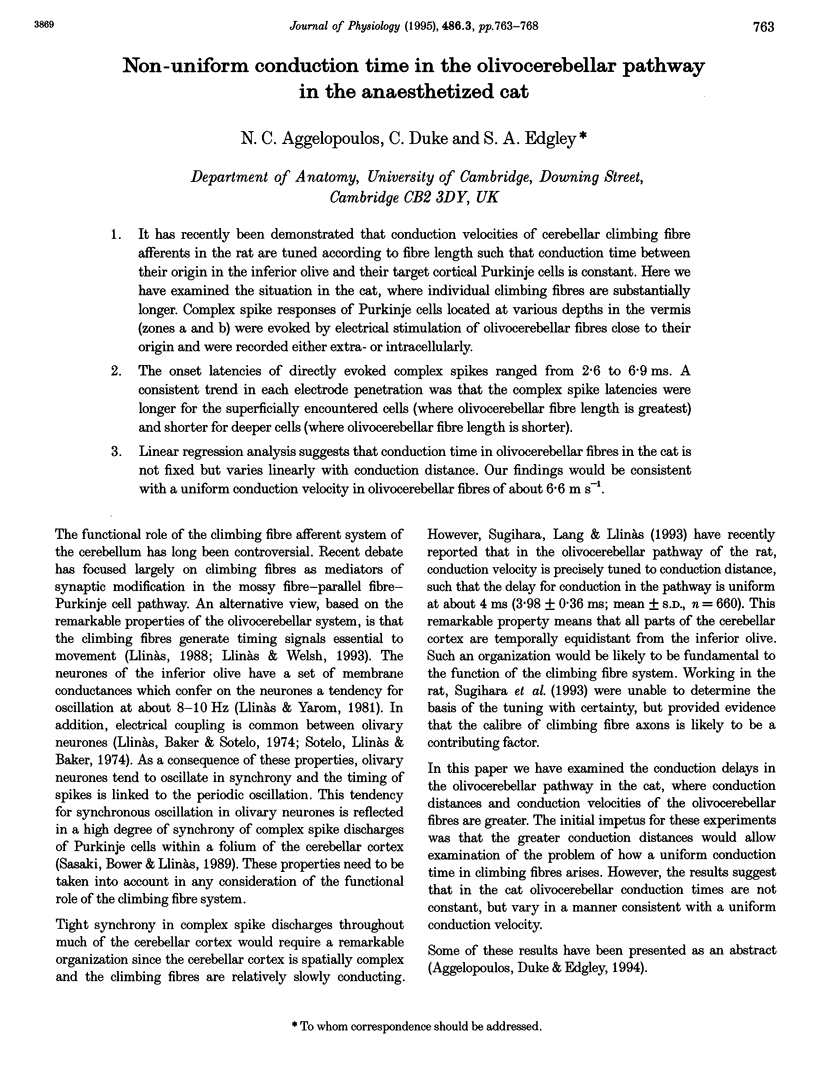
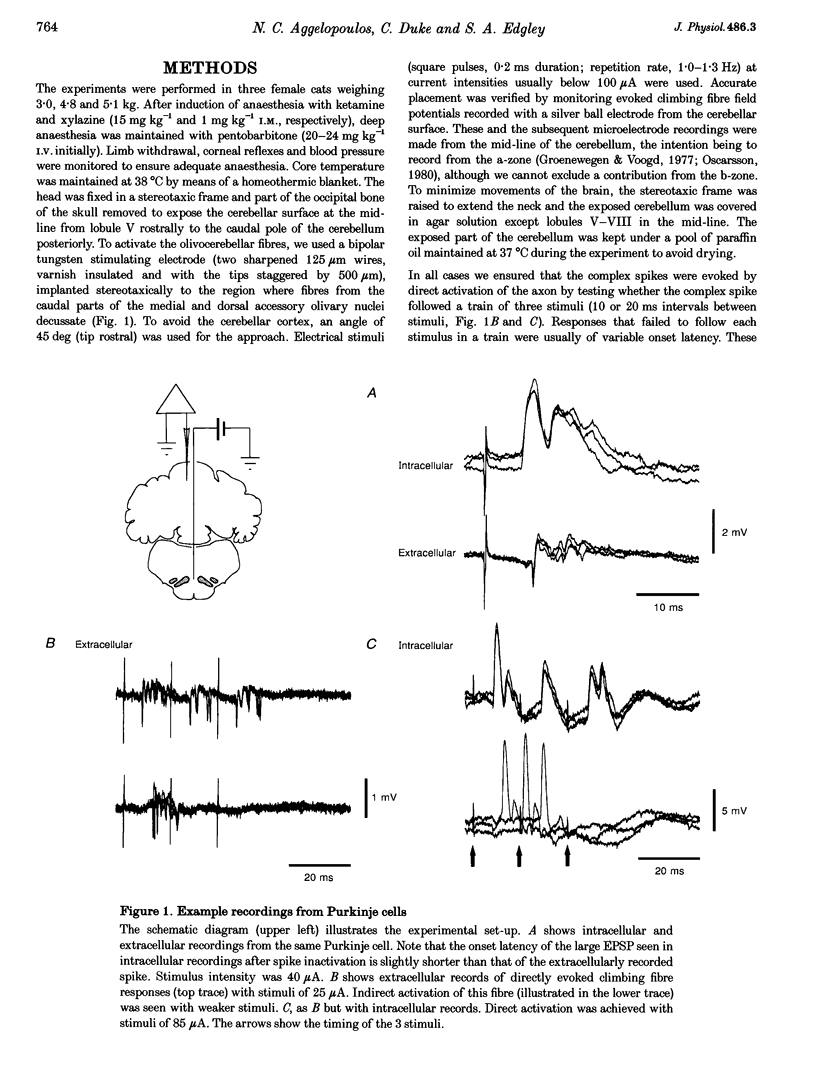
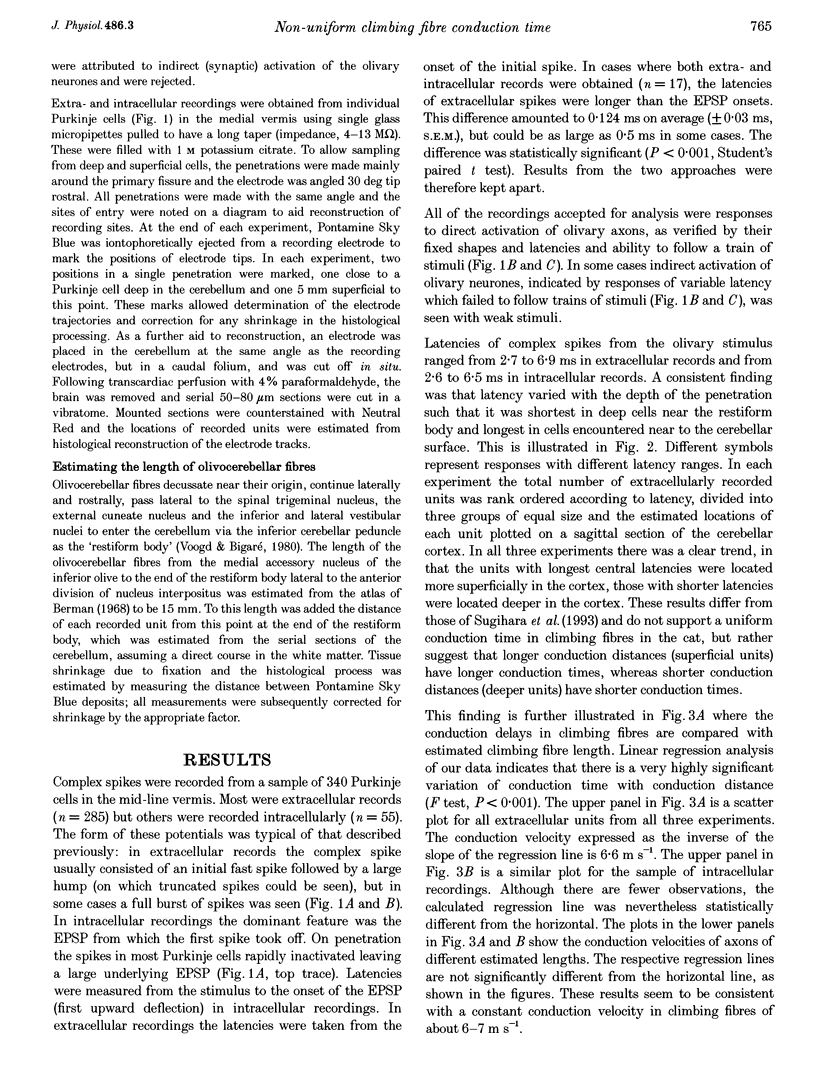
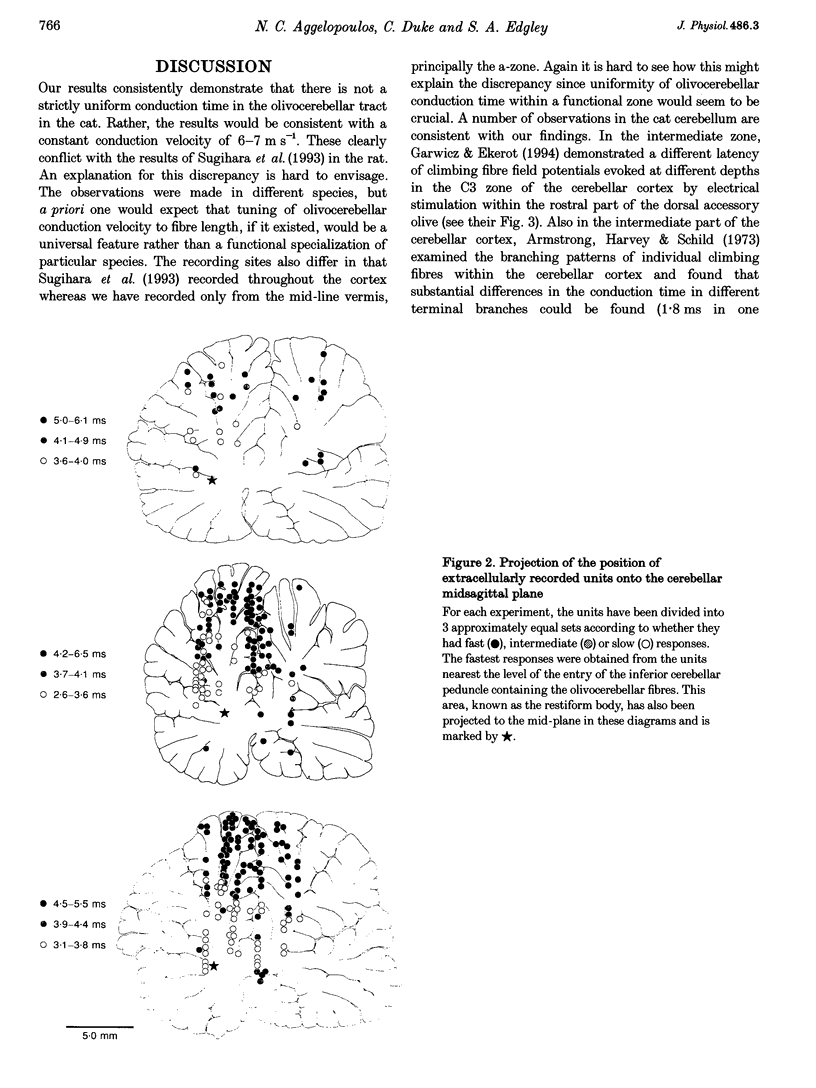
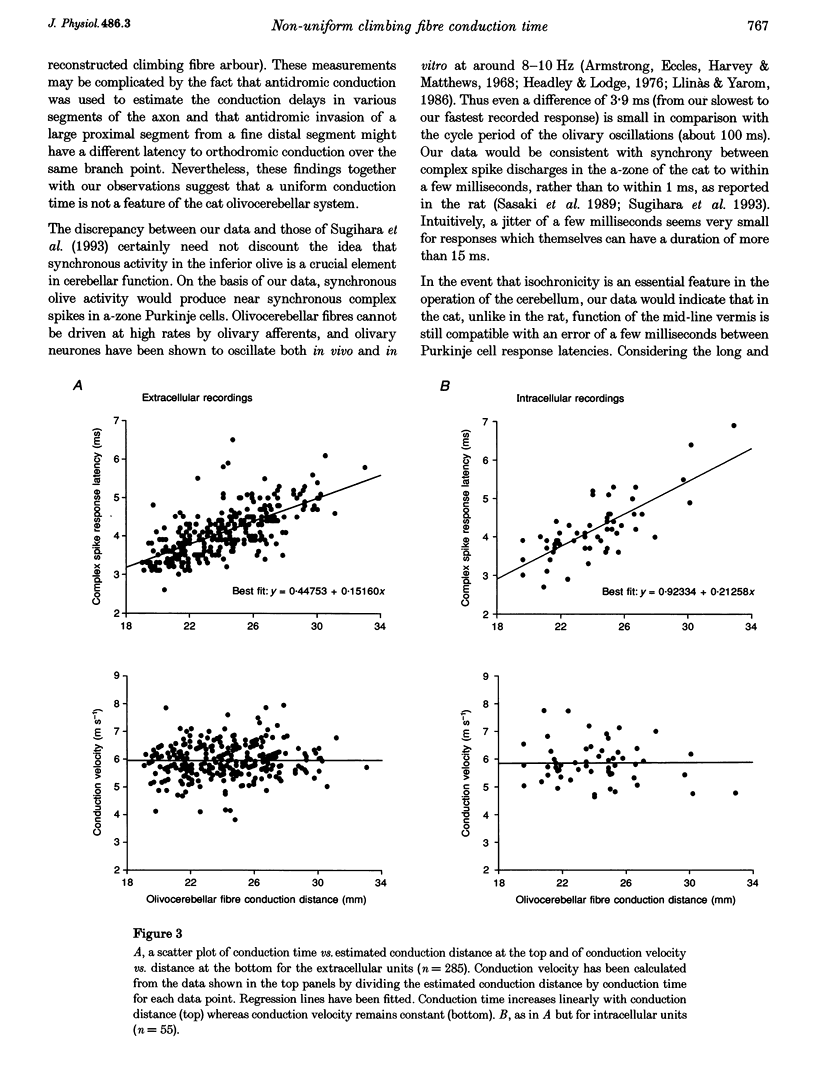
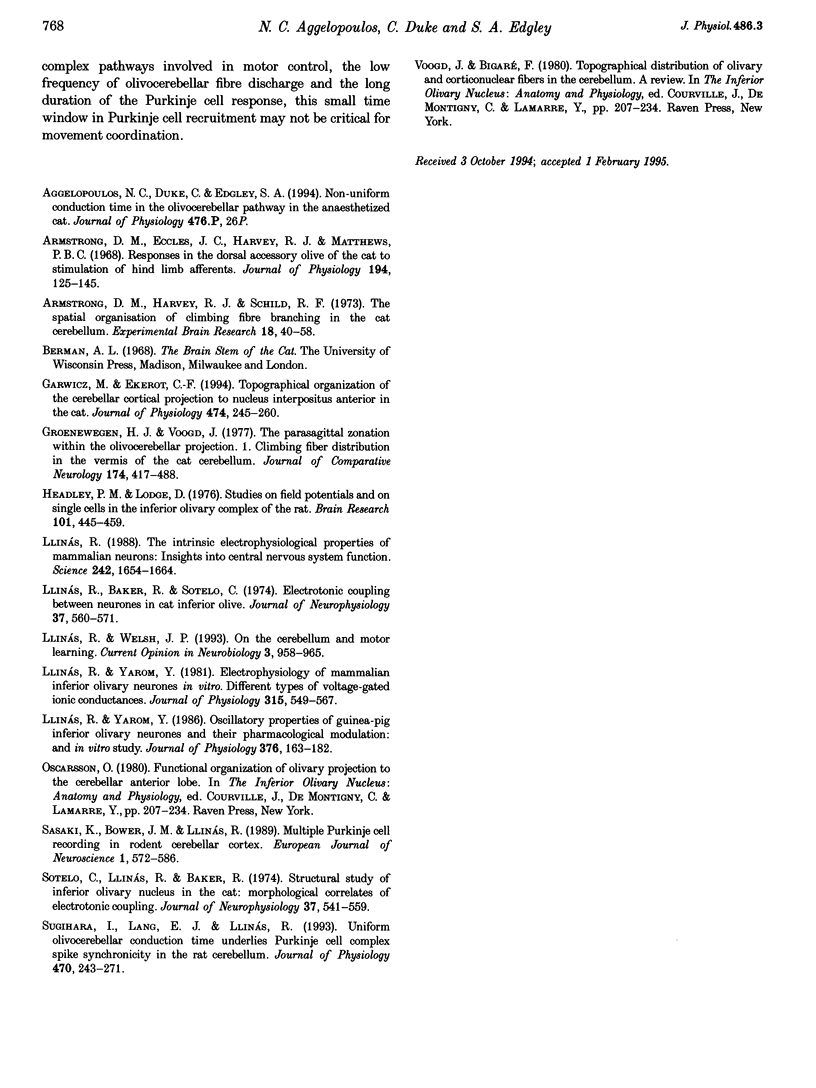
Selected References
These references are in PubMed. This may not be the complete list of references from this article.
- Armstrong D. M., Eccles J. C., Harvey R. J., Matthews P. B. Responses in the dorsal accessory olive of the cat to stimulation of hind limb afferents. J Physiol. 1968 Jan;194(1):125–145. doi: 10.1113/jphysiol.1968.sp008398. [DOI] [PMC free article] [PubMed] [Google Scholar]
- Armstrong D. M., Harvey R. J., Schild R. F. The spatial organisation of climbing fibre branching in the cat cerebellum. Exp Brain Res. 1973 Aug 31;18(1):40–58. doi: 10.1007/BF00236555. [DOI] [PubMed] [Google Scholar]
- Garwicz M., Ekerot C. F. Topographical organization of the cerebellar cortical projection to nucleus interpositus anterior in the cat. J Physiol. 1994 Jan 15;474(2):245–260. doi: 10.1113/jphysiol.1994.sp020017. [DOI] [PMC free article] [PubMed] [Google Scholar]
- Groenewegen H. J., Voogd J. The parasagittal zonation within the olivocerebellar projection. I. Climbing fiber distribution in the vermis of cat cerebellum. J Comp Neurol. 1977 Aug 1;174(3):417–488. doi: 10.1002/cne.901740304. [DOI] [PubMed] [Google Scholar]
- Headley P. M., Lodge D. Studies on field potentials and on single cells in the inferior olivary complex of the rat. Brain Res. 1976 Jan 23;101(3):445–459. doi: 10.1016/0006-8993(76)90470-4. [DOI] [PubMed] [Google Scholar]
- Llinas R., Baker R., Sotelo C. Electrotonic coupling between neurons in cat inferior olive. J Neurophysiol. 1974 May;37(3):560–571. doi: 10.1152/jn.1974.37.3.560. [DOI] [PubMed] [Google Scholar]
- Llinás R. R. The intrinsic electrophysiological properties of mammalian neurons: insights into central nervous system function. Science. 1988 Dec 23;242(4886):1654–1664. doi: 10.1126/science.3059497. [DOI] [PubMed] [Google Scholar]
- Llinás R., Welsh J. P. On the cerebellum and motor learning. Curr Opin Neurobiol. 1993 Dec;3(6):958–965. doi: 10.1016/0959-4388(93)90168-x. [DOI] [PubMed] [Google Scholar]
- Llinás R., Yarom Y. Electrophysiology of mammalian inferior olivary neurones in vitro. Different types of voltage-dependent ionic conductances. J Physiol. 1981 Jun;315:549–567. doi: 10.1113/jphysiol.1981.sp013763. [DOI] [PMC free article] [PubMed] [Google Scholar]
- Llinás R., Yarom Y. Oscillatory properties of guinea-pig inferior olivary neurones and their pharmacological modulation: an in vitro study. J Physiol. 1986 Jul;376:163–182. doi: 10.1113/jphysiol.1986.sp016147. [DOI] [PMC free article] [PubMed] [Google Scholar]
- Sasaki K., Bower J. M., Llinás R. Multiple Purkinje Cell Recording in Rodent Cerebellar Cortex. Eur J Neurosci. 1989 Jan;1(6):572–586. doi: 10.1111/j.1460-9568.1989.tb00364.x. [DOI] [PubMed] [Google Scholar]
- Sotelo C., Llinas R., Baker R. Structural study of inferior olivary nucleus of the cat: morphological correlates of electrotonic coupling. J Neurophysiol. 1974 May;37(3):541–559. doi: 10.1152/jn.1974.37.3.541. [DOI] [PubMed] [Google Scholar]
- Sugihara I., Lang E. J., Llinás R. Uniform olivocerebellar conduction time underlies Purkinje cell complex spike synchronicity in the rat cerebellum. J Physiol. 1993 Oct;470:243–271. doi: 10.1113/jphysiol.1993.sp019857. [DOI] [PMC free article] [PubMed] [Google Scholar]


